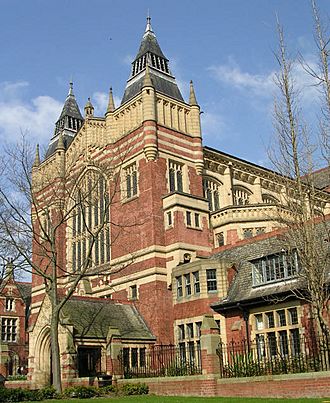Great Hall of the University of Leeds facts for kids
Quick facts for kids The Great Hall |
|
|---|---|

The Great Hall Building of the University of Leeds
|
|
| General information | |
| Architectural style | Gothic |
| Town or city | Leeds |
| Country | England |
| Coordinates | 53°48′27″N 1°33′16″W / 53.807570°N 1.554547°W |
| Construction started | 1884 |
| Completed | 1894 |
| Cost | £22,000+ |
| Client | Yorkshire College |
| Design and construction | |
| Architect | Alfred Waterhouse R.A. |
The Great Hall is a special building at the University of Leeds in West Yorkshire, England. It's known as a "grade II listed" building, which means it's important for its history and architecture. The building looks like it's from the Gothic period, but it was actually built much later. This style is called Gothic Revival.
Today, the Great Hall is mainly used for big events. These include important ceremonies like graduations and also for student exams. Long ago, the space under the main hall, called the undercroft, held the university's library books. This was before the Brotherton Library opened in 1936. The Great Hall is a great example of the many different building styles you can see at the University of Leeds. It's also a classic example of a "red brick university" building.
Contents
History of the Great Hall
The Great Hall stands on land that used to be the Beech Grove Hall Estate. The Yorkshire College bought this land in 1879. This college later joined the Victoria University, along with the University of Liverpool and the University of Manchester.
Building the Great Hall
The old estate was taken down in 1884 to make way for new buildings. These included the Clothworkers buildings, the Baines Memorial Wing, and the Great Hall itself. A famous architect named Alfred Waterhouse designed these buildings. He also designed the well-known Natural History Museum in London.
Waterhouse used red bricks and stone from Bolton Wood for his designs. He built them in a style called Gothic Collegiate. This style made the buildings look like old colleges.
What is a Red Brick University?
The collegiate style used by Alfred Waterhouse helped create the term "red brick university." This phrase was first used by Edgar Allison Peers in 1943. He was a professor at the University of Liverpool. He used the term to describe the Victoria Building at his university.
Since then, the term "red brick university" describes six important universities. These were founded around 1900. They include the University of Birmingham, the University of Bristol, the University of Liverpool, the University of Leeds, the University of Manchester, and the University of Sheffield.
Purpose and Cost of the Building
The Great Hall was built in the Gothic style. It was meant to be the university's main library. Building it cost about £22,000. This money was raised partly by people donating.
It served as the main library until 1936. That's when the Brotherton Library and other new areas like the Parkinson Building opened. Besides being a library, the Great Hall was also used for meetings, exams, and public talks.
Opening and Legacy
The Duke and Duchess of York officially opened the Great Hall in October 1894. If you stand at the door of the Great Hall today, you can see nearly 150 years of university buildings. You can see the red brick style of the early Clothworkers buildings. There's also the Portland stone of the Michael Sadler arts building. And the modern steel and glass of the Marjorie and Arnold Ziff Building.
This mix of styles shows why Leeds is one of the largest and most diverse universities in the UK. The Great Hall is still used today for meetings, exams, and graduation ceremonies. It's one of the few buildings on the University of Leeds campus that still shows the classic red brick style. This style is special to a few civic universities in the United Kingdom.


